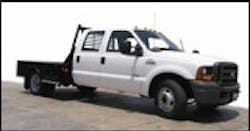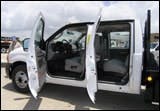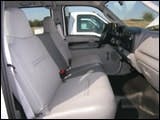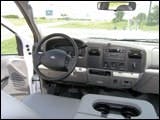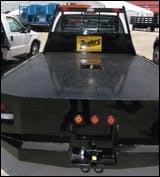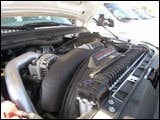Basic Ford F-350 Truck Offers Deluxe Performance
Some jobs demand tough but simple trucks. Tough can be had, but there's nothing simple available anymore. Any modern motor vehicle must meet customer demands for performance, economy and comfort, along with government emissions limits. These conspire to make for highly complex products that are bristling with technological advancements.
However, cutting back on exterior and interior niceties results in trucks that look plain-Jane, even if they're far from it under the skin. Case in point: This Ford F-350 Super Duty Crew Cab XL, which was among many displayed at a Ford demonstration last summer. Its XL interior included vinyl-covered seats and rubber floor mats, so it looked like it could be hosed out. All the electronics on and under the dashboard and probably under the floor would preclude the hose treatment, though. No, "wipe-out" is a better term to describe its interior package.
The truck's XL trim is Ford's base level, and it was built to work. It didn't pretend to be anything fancy, and that's why I was drawn to it. It sat in a row of other F series trucks on display at a dealership in San Antonio, Texas, on an oppressively hot and humid day last summer. Inside a nearby air-conditioned tent, Ford marketing executives were remarking on the success of the F series since that designation first appeared in 1948. Ford and its dealers have sold more than 28 million Fs in the past 57 years, they said.
The series now ranges from F-150 to F-750 in nomenclature and 6,500 to 33,000 pounds in GVW ratings. The executives, jubilant from record sales through July '05, were gunning for more. But the hurricanes of late summer and spiking fuel prices in early autumn seriously slammed sales, and 2005 numbers closed at 901,463 — still the third best year in the 57-year history of the product line.
This F-350 was a cab-and-chassis model with some hefty running gear, including dual wheels at each end of the rear axle, and a GVW rating of 13,000 pounds. I imagined the vehicle going to work for a construction contractor who'd send it and its crew to hot, dusty sites with supplies tied onto its steel flatbed body. They'd get there in fair comfort and decent style, even though the truck was about as plain as they come.
Its paint was the staid "Oxford white" that's common on Fords. There was no chrome exterior trim, and the plastic grill and bumper covering were a dull, dark grey. Silver would look nicer and the chrome-plated noses on fancier models make them smile, but for sure this one will never rust. In the cab, vinyl covers on the two bench seats appeared tough and easy to wash, though a lot of buyers might never bother with that. The four-door cab was long and wide enough that six burly guys could seat themselves comfortably and, in spite of the plain seat coverings, they'd ride in reasonable style.
My ride in the F-350 was relatively short, but long enough for me to appreciate its quickness and comfort. Its air conditioning was powerful, and the truck rode well, was quiet, and handled easily. The seats looked simple but were rather supportive, and a fold-down armrest in the front had a storage compartment and even a pair of cup holders. The rear seat folds to make room to stow tools and other items best kept locked up. That vinyl might get hot and sticky on one's backside, but the air conditioning makes it bearable.
The instrument panel was as well equipped as any SuperDuty truck. The rotary HVAC switch knobs are big and their functions easy to understand; high-end models get push buttons that you have to study to use, at least at first, but such controls are considered upscale, even if they're more difficult to use. I always frown when I look at F series' engine-condition gauges because they're not numbered, and needles swing into "normal" ranges that you hope are okay. Then again, F series gauges have been this way forever and the trucks still get down the road.
Triton gasoline V-8 and V-10 engines, recently updated with three-valve-per-cylinder heads and other advances and paired with a smooth TorqShift five-speed automatic transmission, are standard in F-250 and F-350 SuperDuties. This F-350 had the International-built Power Stroke diesel. The 6-liter (363-cubic-inch) V-8 diesel makes as much as 325 horsepower and 570 pounds-feet, so the truck really scooted, more than keeping up with auto traffic on the nearby streets and freeways on San Antonio's far east side.
Comparable diesels from GM and Dodge are stronger, but Ford says its Power Stroke is tuned to deliver more usable power and torque at low and midrange revs where most engines spend most of their working lives. It's quiet and almost smoke-free. A demonstration a year before at Ford's Arizona proving grounds shows that the diesel pulls trailers with authority and stops them quickly, too, thanks to an optional electrical brake unit that's built into the dash and works with the truck's own brakes.
The TorqShift five-speed works well with either the diesel or the Triton gas engines I drove at that demo. There's a trend toward six- and even seven-speed automatics in autos, and I think it's overkill, as any fuel economy and performance gain is offset by greater complexity and, eventually, higher repair costs. Five ratios seem just about right for most uses, and even a modern four-speed automatic is entirely adequate, it seems to me.
Like other builders, Ford builds its cab-chassis vehicles with body builders in mind. Frames are kept "clean" and plug-in electrical boxes make mounting and wire connections fairly easy. This truck had a locally fabricated flatbed fashioned of heavy gauge diamond-plate steel. In its center was a fold-up plate covering a ball hitch for a gooseneck trailer, and there was another ball hitch at the rear for a tongue-type trailer.
A weighty backhoe or small excavator could ride easily on an equipment trailer behind the F-350. That loaded trailer could weigh as much as 16,700 pounds and still be within the truck's towing capacity, according to Ford specs. The truck alone could carry 5,700 pounds on that flatbed (less passengers and the body's own weight), so it's got a strong constitution.
I doubt that anybody driving this Ford will ever complain about lack of carrying or towing capacity, or power, or much of anything. It's a nice truck just as it sits, and your dealer will happily sell you a more nicely trimmed XLT or Lariat version. They'd be fancier, but they wouldn't work any harder than this plain-Jane version.
